Stat Analysis: Badstuber’s brilliant build-up
There have been tons of articles about Holger Badstuber in the last few years, most of them talking about his health – fitness worries, praising his mental strength, attempting to explain the medical side, you name it. Although one has to admit that this was an understandable if not natural development, it seemed as if Badstuber’s qualities on the pitch were more and more forgotten despite Guardiola regularly singing his praises.
Editor’s note: I wrote this article for the German website a few weeks ago which explains why the graphics are in German (they’re easy to understand anyway).
Straight to the top
Looking back at the beginning of his professional career, you realize that Badstuber’s mental strength already became obvious at an early stage. He entered the 2009 preseason without any Bundesliga experience whatsoever and then, in his very first season, went on to appear in 33 of 34 matches for the league champions. There’s no doubt that he benefitted from coach Louis van Gaal, who was in dire need of a left-footed modern centerback, but nevertheless it was an extreme increase in both workload and pressure that hardly any 21-year-old could handle. As a young player in your first year with the pros, to play 2.924 out of 3.060 minutes in the Bundesliga and only miss time in the Champions League because of a yellow card suspension, you need serious balls.
Furthermore, there was no positional safety for Badstuber. In his very first season, he continuously had to switch between centerback and full-back like you’d expect from a veteran. The same reason caused the first low point of his career. At the 2010 World Cup, he was wasted as a left-back and, in the most ridiculous fashion, became the scapegoat of an entire nation when he was left alone and consequently struggled to defend the (back then) skillful winger Milos Krasic. That decision didn’t backfire for Jogi Löw simply because he was lucky enough to have another adaptive defender in his squad (Jerome Boateng).
At that point, Holger Badstuber’s reputation in Germany was ruined. Too slow, too clumsy – just like you would expect to hear at your local pub, a ball-playing centerback was criticized for not being an athletic full-back. Even after several decent performances as centerback, he remained a suspect on the national level, despite the system of the national team making every defender look bad. At the same time, it was routinely ignored that Badstuber never had to develop into a regular for Bayern, simply because he immediately became one and always remained one. Until that well-known collision in December 2012…
Return to the top
Now, almost three years later, a question mark still remains. How much is left in the tank for Badstuber? How much can his body take? We neither want to nor can judge if there’s a connection between his injuries, that’s something best left for the medical experts. What we can say for sure is that his attitude won’t be a problem because it is flawless.
For quite some time, there was a second big question mark. How close to the previous level can you get after such a big injury? The good news is that this question mark no longer exists. Last season, Badstuber proved in impressive fashion that he’s still capable of performing at his peak level. Hell, it almost seemed as if he could take another step forward with increased playing time.
One of Holger Badstuber’s biggest strengths surely is the build-up, which is why he’s such a perfect fit for Bayern’s system. He might not be an aggressive tackler like Medhi Benatia or have the quarterback-like skill of Jerome Boateng to cut through an entire midfield with a single pass but he’s right at the top when it comes to reliable ball distribution under pressure.
Statistical analysis
A simple way of proving that would be to mention that Badstuber had the highest passing accuracy of any Bundesliga player (93,3%). However, this reasoning would be a bit thin, considering that different systems include different risks and that massively varying passing quantities might show an inflationary trend.
As part of this analysis, we checked the stats of all Bundesliga centerbacks (as defined by whoscored) who had more than 8 appearances in 2014-15. In order to avoid the extreme deviation caused by short appearances late in a match, we used the stats per 90 minutes. For further usefulness, we looked at short and long passes separately.
Let’s begin with short passes, a key feature of the Bayern game. In fact, 89,5% of FCB centerback passes are short passes, only Lucien Favre’s Gladbach comes close to that with 88,9%. To compare, the league average is 81,1%.
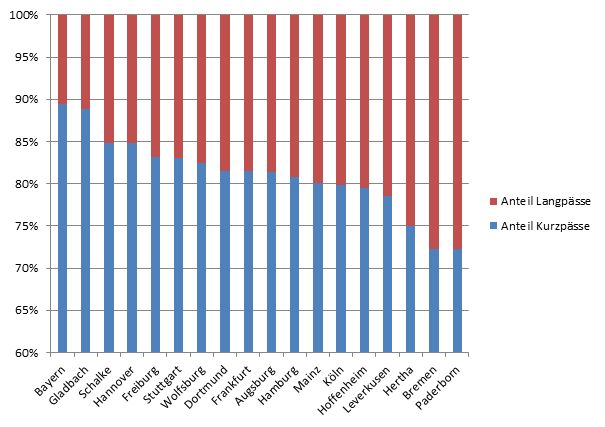
So when you look at those numbers on a player-to-player basis, it’s no surprise that the kings of short passes are mainly Bayern and Gladbach players. This is not only the case for passing quantity but for accuracy as well, it seems as if there is at least a bit of a connection between the two (R² value: 0,3434), which isn’t all that surprising.
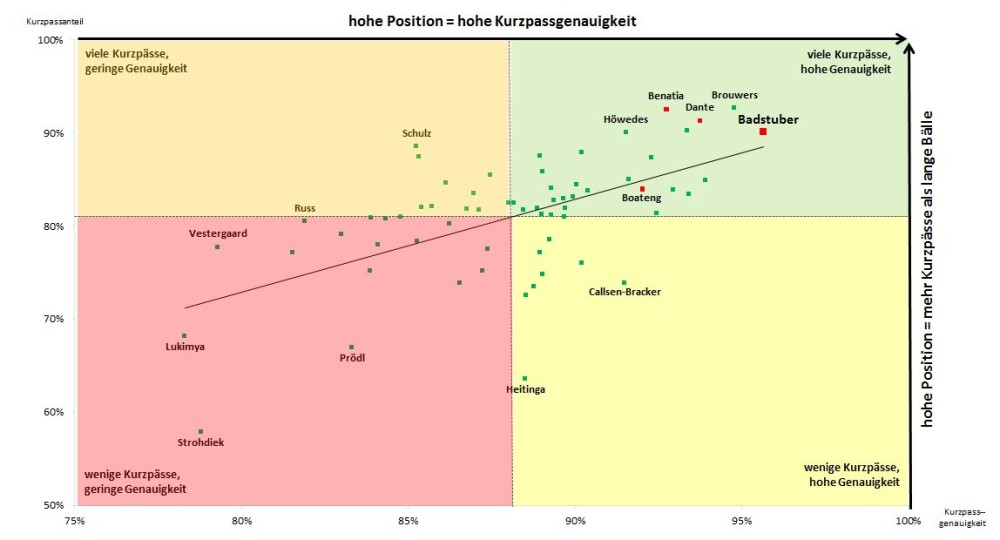
Although you can already spot a bit of an intrasquad tendency in favor of Badstuber, you could easily argue that he benefits from the system and isn’t anything special league-wide. This is why we added the team averages to the mix, calculating and visualizing the delta of every player compared to his team’s average.
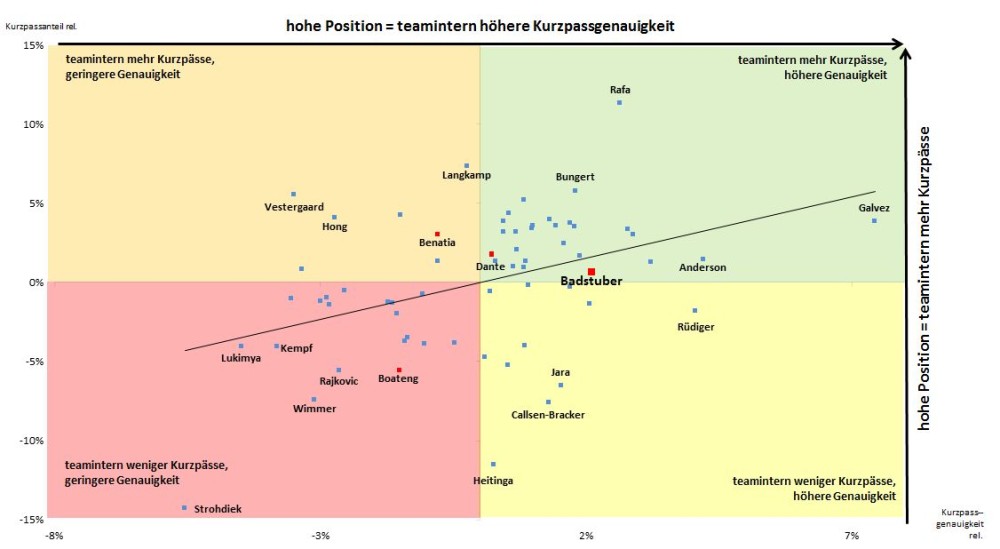
Here you can see that Badstuber offers one of the best values in the league but isn’t at the absolute top. However, there’s an easy explanation for most of it. Statistical abnormalities such as Alejandro Galvez and Rafa, both Spanish by the way, benefit from the ugly football of their teammates. Solid short passing is a lot more noticeable when you play for a team like Bremen or Paderborn that rely mainly on their centerbacks playing long balls. However, if anyone has a meaningful explanation for Bamba Anderson’s high numbers, please let us know.
Furthermore, those intrasquad differences need to be put into perspective, with the depth at Bayern being a lot better than at other clubs. Simply put, it’s more difficult to set yourself apart from other world-class players.
Now you could still make the case for this proving nothing about Holger Badstuber’s passing and build-up qualities. After all, what if all of his passes are safe passes to nearby teammates? It’s an understandable theory that’s absolutely torn apart by the long ball statistics.
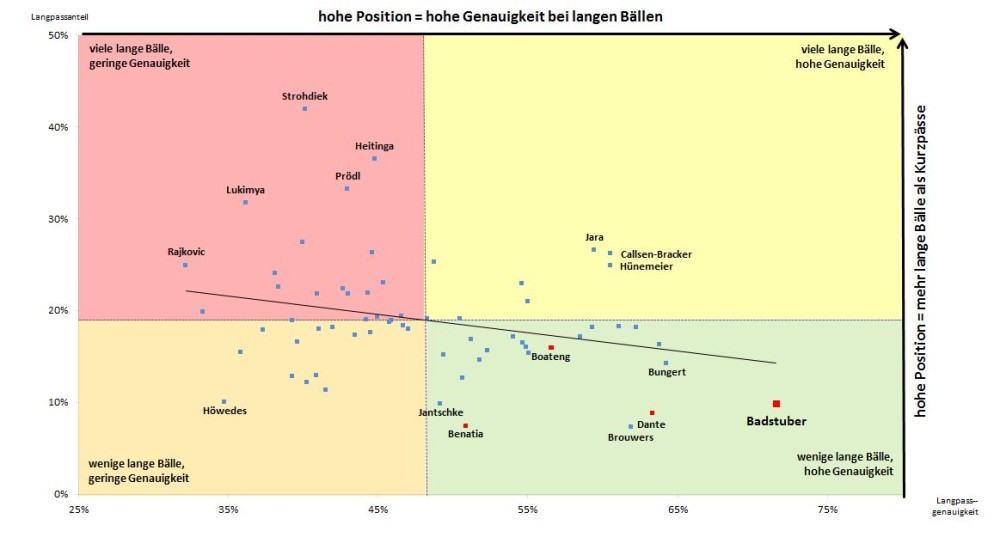
Once again, it’s mainly Bayern and Gladbach on top. It actually turned out that fewer long balls lead to a higher accuracy. It’s safe to assume that those who play fewer long balls see them as a tool to enter empty spaces or for positional shifts, as opposed to the British long ball spam of technically impaired teams.
The gap between Badstuber and the rest of the league is simply incredible. His long ball accuracy of 71,6% is an absolute world-class value, the Bundesliga average is a mere 48,2%. Another thing that’s noticeable is how few long balls Medhi Benatia plays, proving his very protecting role in build-up. It’s gonna be interesting to see if his passing abilities will be trusted more once he’s spent an entire preseason with the team.
Looking at the intrasquad numbers, Badstuber’s quality once again becomes obvious.
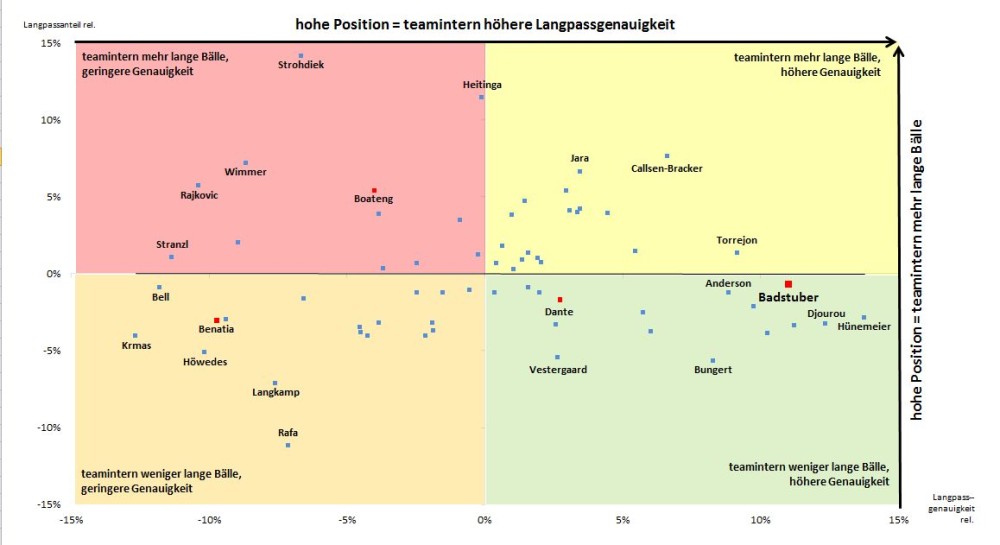
Long balls played by Badstuber were 11% more accurate than those of his teammates, a very meaningful difference especially in Bayern’s pass-heavy system.
Conclusion
To sum up, the numbers clearly confirm the passing and build-up qualities that Holger Badstuber offers. Despite the awfully long injury break, he was top of the league both in absolute and relative terms.
Badstuber had the league’s highest short pass accuracy (95,6%) and, despite his strong teammates, he was in the top 10 in terms of the intrasquad delta (+2,1%). Even more impressive are the long ball values. Here, Badstuber again led the league in accuracy with 71,6% (#2: 64,3%) and had the fourth-best intrasquad delta (+11%). Holger Badstuber still is one of, if not the strongest build-up centerback of the Bundesliga.



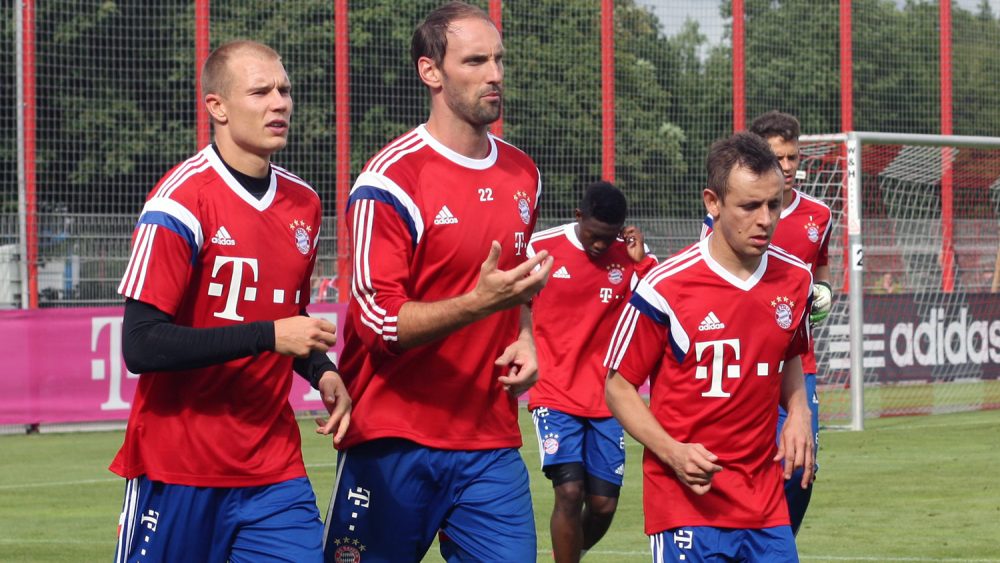
 August 25, 2015
August 25, 2015 


